9 Best Shopify Clothing Store Examples & How to Build One?
At Shopify, you will find over a million independent businesses, coming from various industries, trying to create their versions of success through eCommerce. Fashion is among the most invested fields, considering the importance of it in everyday life. And, perhaps, you are thinking of starting your own Shopify clothing store as well?
Then some inspiration from the best Shopify clothing store examples is just what you need. What are their products made of? How did they use photography? Which method do they use to promote their brands? Each business has its strategy to improve its conversion rate and make visitors stay a bit longer.
Exclusive Offer: Get Shopify 33 days for just $1 + The Online Store Starter Kit
Start your 3-day free trial, and enjoy your first month of Shopify for $1 plus the premium package designed especially for new Shopify merchants!
In the highly competitive environment of the fashion industry, learning how to stand out is probably the most important lesson. That is why I took the time to find these next handful of best Shopify clothing store examples. They are having great success because of their different tactics to attract, engage, and convert online consumers.
After reading, you will be able to improve your product design, functionality, and overall experience of your online clothing store. Additionally, I will show you how to build a Shopify clothing store from scratch with real actionable steps. So, put on your best designer clothes, and let’s get started!
Best Shopify clothing store examples
The fashion industry is wild, to say the least. There are new trends and viral items every day, while some styles are just here to stay no matter what. Also, with different age groups, consumers have different needs in their clothing. Considering people are staying mostly inside last year, many are still putting on their best looks for a Tik Tok video.
But that is the whole fun of starting a Shopify clothing store as well. You get many opportunities to prove that your products can find loyal customers. Combining with a robust eCommerce platform like Shopify, a clothing store owner only needs to come up with the best items and not worry about downtime or sudden traffic surge.
The next Shopify clothing store examples found a way to stand out in the fashion market, build a loyal customer base, and provide the best service even during peak sale times. Take a look and write down the key lessons from these clothing brands.
Big Bud Press
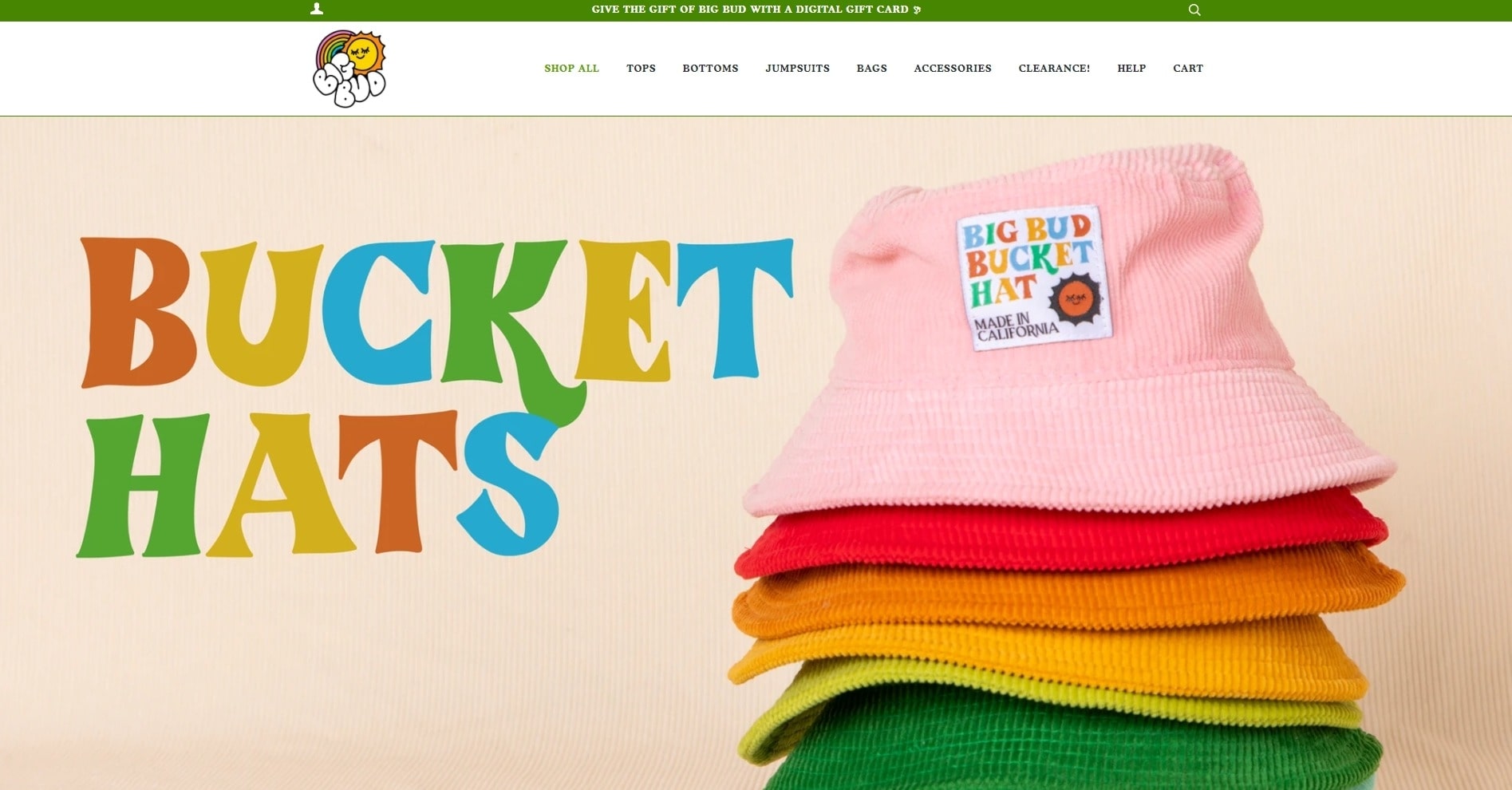
Based in Los Angeles, Big Bud Press is a clothing store specializing in unisex and size-inclusive items. Let’s go through each section to see what they do right with their Shopify fashion store.
First of all, visitors will immediately see a high-resolution hero image and some key navigators to start. This is above the fold area of the website, where you can introduce your brand’s personality and pique consumer interest. Big Bud Press effortlessly uses the awe factor with stunning images, and especially the use of unprofessional models.
Right off the bat, you will see a diverse group of models with different weights in Big Bud Press clothes. In a fashion world where people are so used to tall and skinny models with perfect faces, the brand roots for users to be comfortable with their own skins. With such a unique approach in photography, the brand sends a clear message of self-acceptance and dedicates to its mission throughout the website.
The navigation bar is also a plus here, clearly showing Product categories, Help, and Cart information. With a primary color of orange on every page, it is hard to forget about Big Bud Press even after leaving the site. Scrolling down and visitors will find details of their brick and mortar stores, where shoppers can come to try the products on.
The product page is worth learning too with high-quality photos, sincere product descriptions, and an original voice. However, there wasn’t a product review section as well as social proof of any kind. Star-ratings with real people feedback is a highly convincing point for consumers, so I wish Big Bud Press added the feature.
Black Milk Clothing
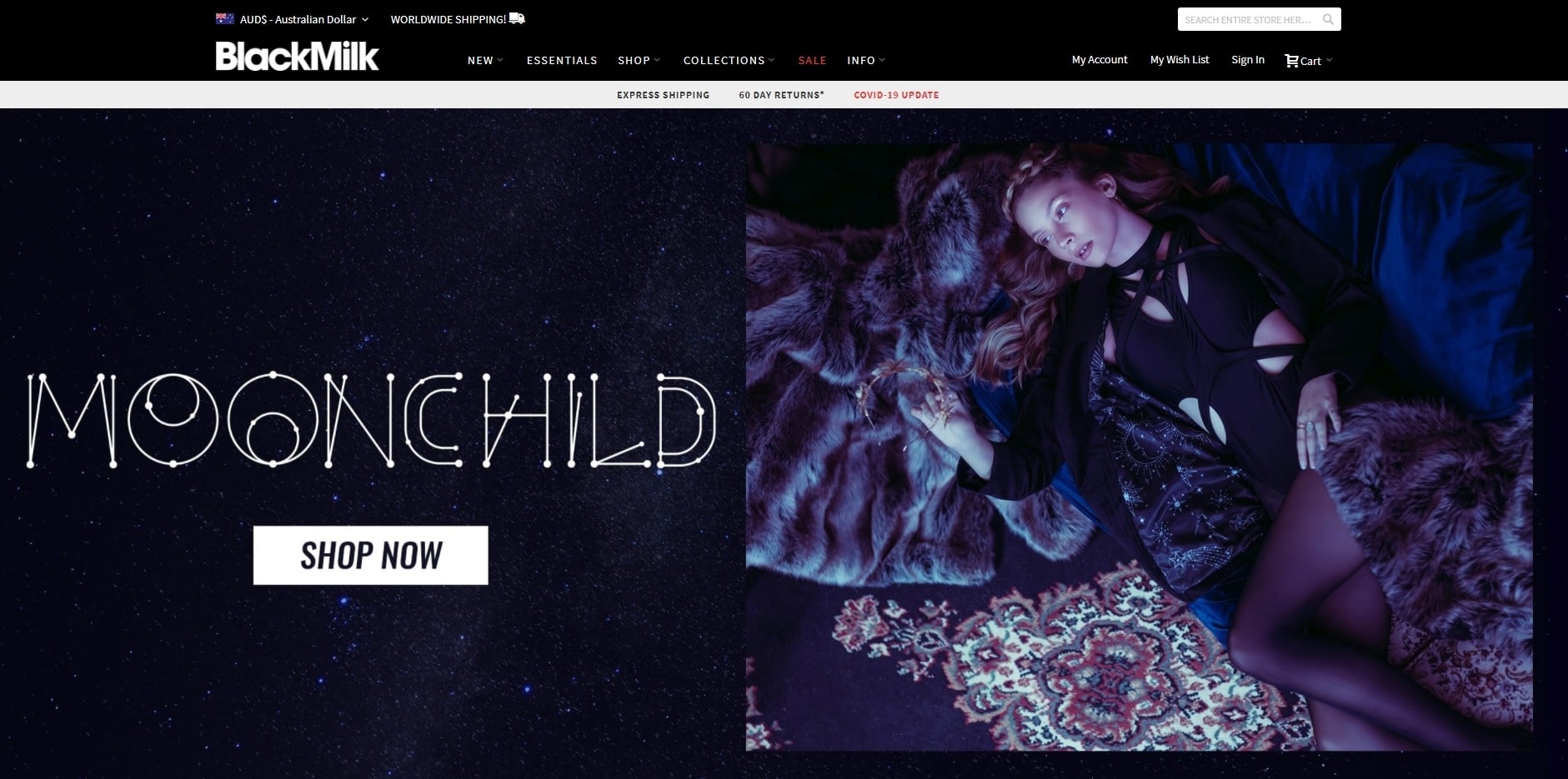
From a humble background, James Lillis of Black Milk Clothing has gone from selling cheap tights to becoming a global brand with a loyal following of female customers.
However, Black Milk really grew its population thanks to the power of content marketing - a blog in the field of leggings fashion. The bold and unique designs have captured the attention of women around the world and created the foundation for today’s strong community of Black Milk fans.
Black Milk’s focus is not on selling but on speaking. They claim their ability to tell stories, social proof, and encourage customers to interact with the brand. That comes from providing value, being authentic, creating community, and building trust through great content.
The first impression is always important so Black Milk introduced their brand in a unique way. There’s a lot going on when you go to the homepage, with video content on the left and an image gallery on the right.
Not to mention all the text templates and overlays. But it worked. And it works because the Black Milk brand has evolved thanks to bold and striking leggings designs. It is important that your website content reflects the real values and the nature of your brand.
Black Milk Clothing contributes a lot to its success in connecting and interacting with customers. One of the ways they’ve done this so well is through Instagram hashtags. With this method, buyers use hashtags when uploading to Instagram. Black Milk collects them and introduces images under products on the website.
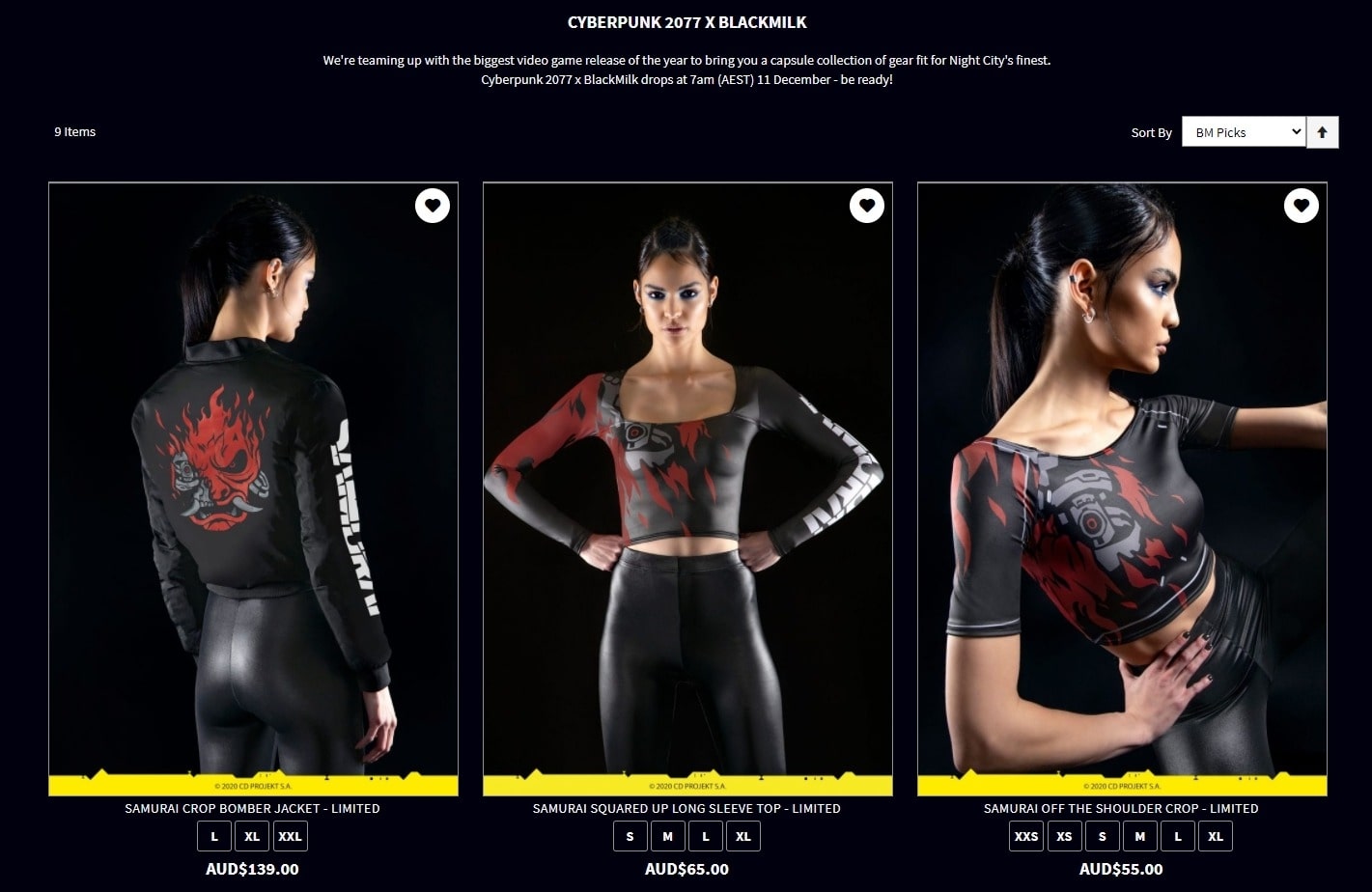
Black Milk also attracts customers with their unique collaborations and collections, naming the last collaboration with Cyberpunk 2077 as an example. The landing page for these collections are often bold, vibrant, and telling a certain story. At the end of the lookbook, there is a simple call to action for buyers to view the collection - which is effective in its own way.
Naja
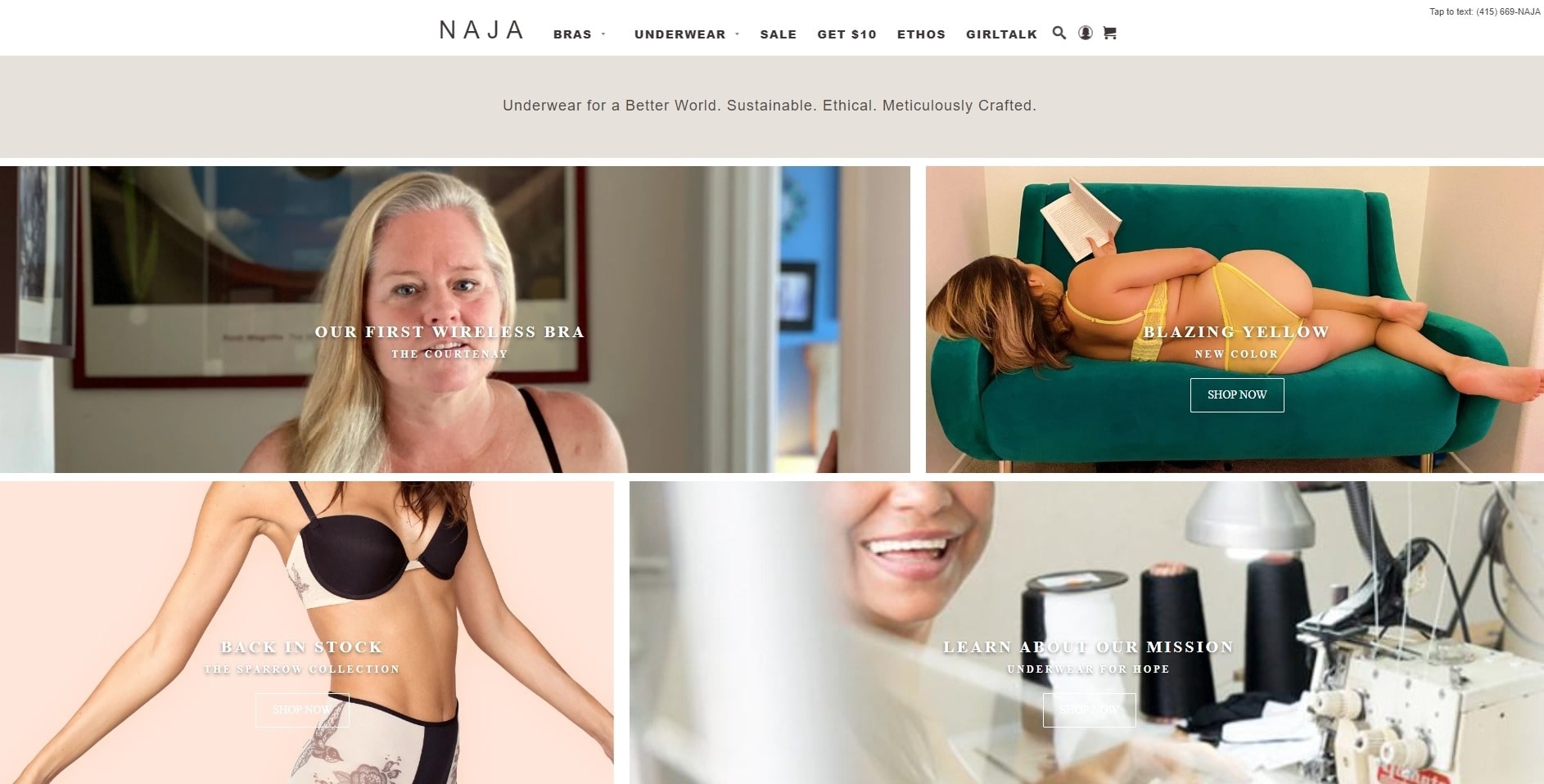
Naja is an undergarments brand created by designer Catalina Girald and Golden Globe-winning actress Gina Rodriguez. The Shopify clothing store offers inclusive underwear in multiple colors to match all shades of skin tones and types of body. Naja also promotes an empowering program by employing single mothers and female heads of households. 2% of its sales support sewing programs at local foundations.
For the eCommerce website, visitors can see the primary tone of the site is nude colors, much like Naja’s products. The hero image is certainly stunning, leaving a strong impression of the brand’s characteristics. I liked the navigation bar very much since it is simple and promotes the loyalty program.
“Get $10” is how Naja draws attention to their loyalty program. In which, customers learn that they can get points by buying, referring to a friend, or simply creating an account. They also have a blog section called “Girltalk” where they feature wonderful women using their products.
On the product page, besides a thoughtful description, buyers can also see the employee that made the item - making the statement of empowering women much more convincing. However, the layout of the product page is a bit off in my opinion since Naja uses too small images.
Tentree
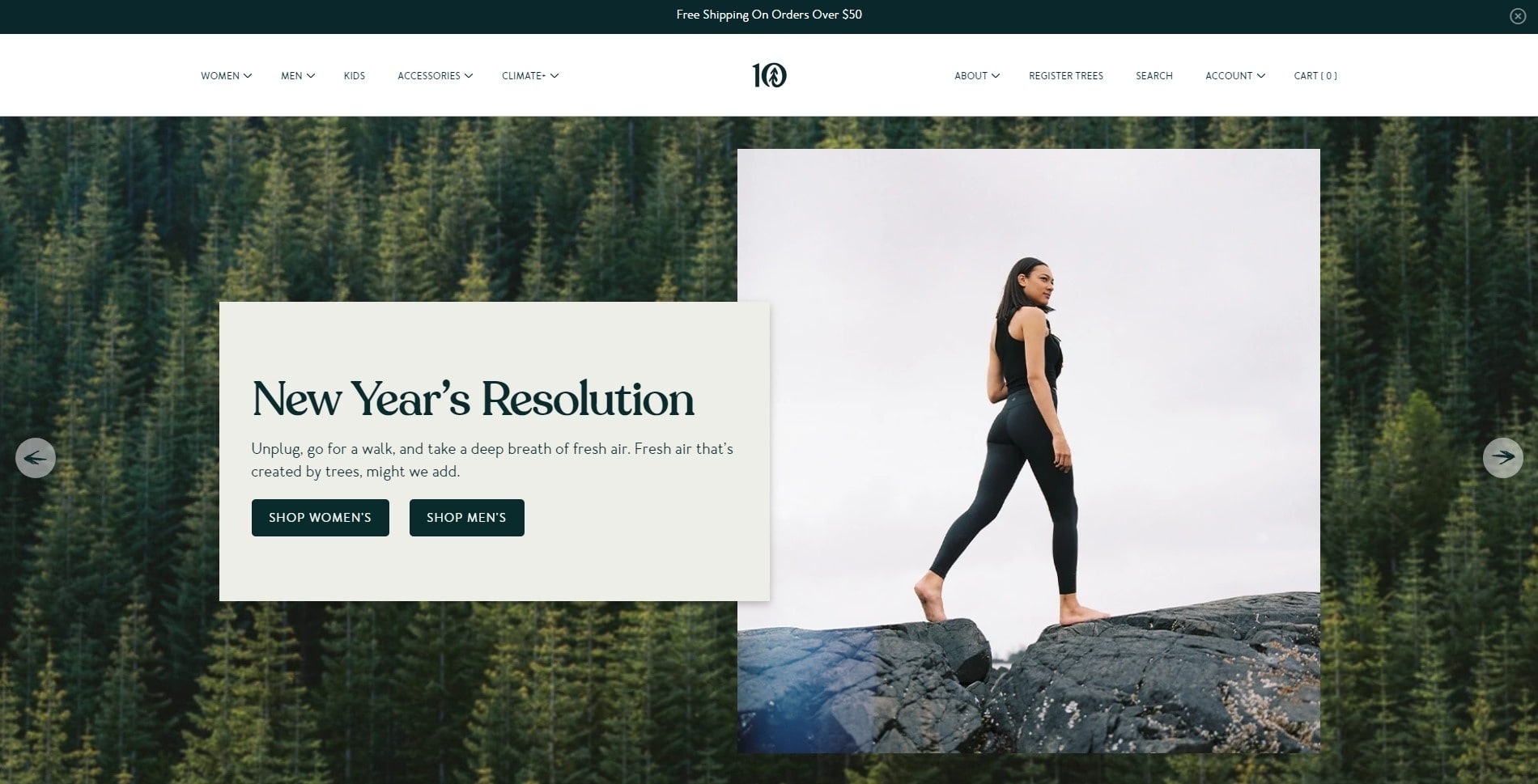
Dave Luba and Kalen Emsley founded Tentree after their time in Hawaii, aiming to positively impact the environment through eCommerce. For every item, and really every item, Tentree would plan 10 trees in over 8 countries. So far, they have planted over 50 million trees, and plan to reach 1 billion trees by 2030.
That is a good lesson for any Shopify clothing store because it is not always about the success of money. By placing a positive impact first, your brand can mean so much more for customers and the world. Tentree also has a Climate+ program, in which buyers can literally pay to get trees planted on their behalf. For the website, Tentree has a Shopify look that is simple yet effective. When visitors scroll down, they will see more of the commitment the company has for the environment, not for making a sale. The only sale attempt is the newsletter signup button for 10% off.
The product page is something I find really efficient too with detailed information on materials and sustainability, while customers can leave reviews below on fit, quality, then leave a star rating. There is also an Instagram feed for buyers to shop the look from other users - which is a good move for upselling.
Hard Graft
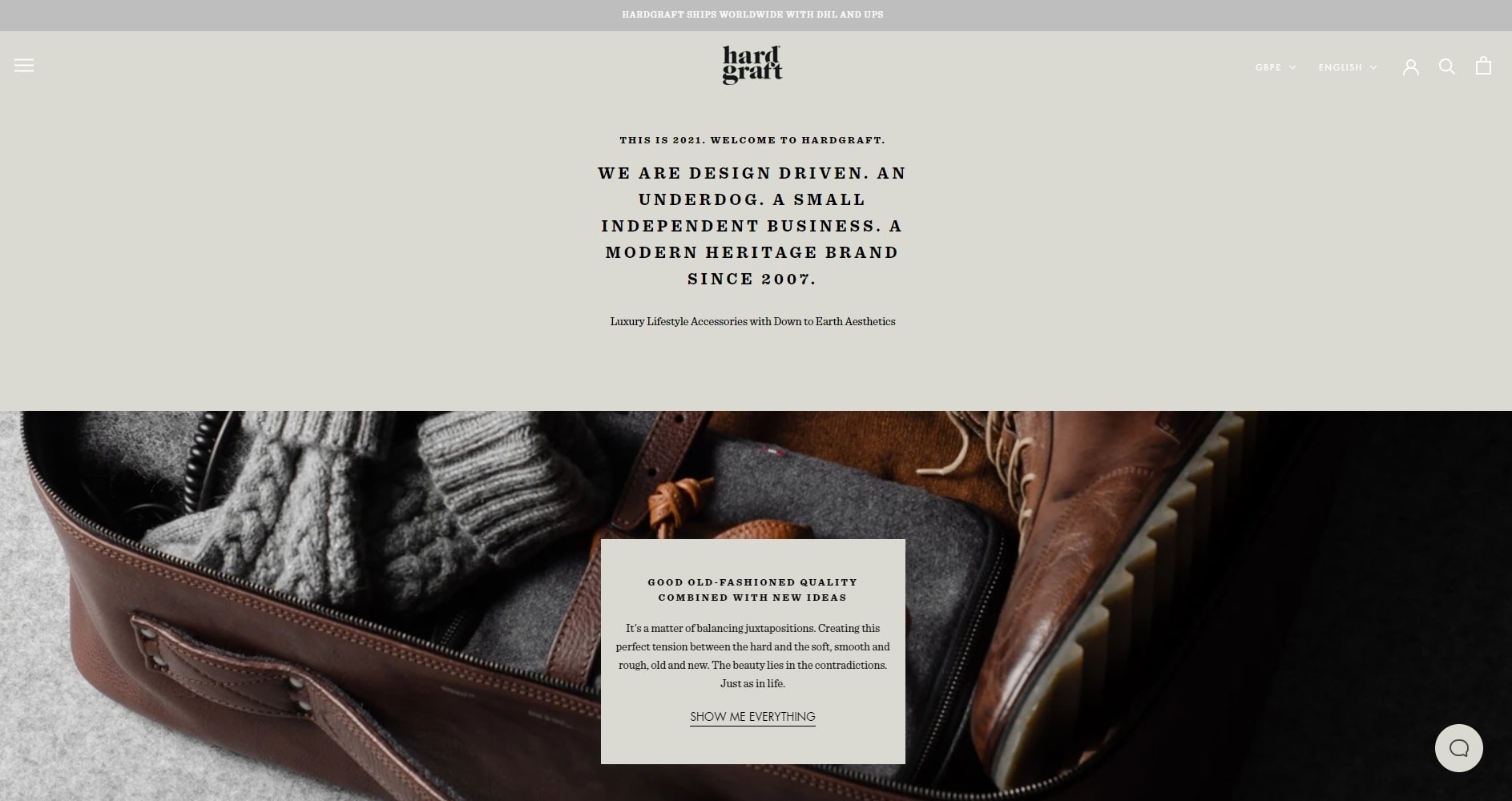
Started in 2007, Hard Graft has been growing a healthy and strong brand organically. They provide items in bags, footwear, device cases, camera bags, and small leather goods. The brand mainly uses leather and wool for their products, using the most basic colors for a minimal approach in design.
In terms of website design, the Hard Graft site is clean and uses neutral tones with grey and brown being the dominant colors. The homepage shows a few key products with customer reviews, and a video demonstrating the brand’s journey. One thing that Hard Graft does differently is hiding the navigation bar to the side and customers can show/hide it with a click.
The headline is unique and sets the brand’s tone pretty well. However, I think Hard Graft can align the words better since I find it to be a bit hard to read. The images are absolutely stunning throughout every page, and making customer reviews a dedicated page is a smart move.
Overall, Hard Graft is a good example of a simple approach in design but still matches the brand’s personality. I would recommend them to have an exit-intent popup to capture leaving visitors since I didn’t find one during my research. Exit-intent popup and emails is a great way to increase the conversion rate, just ask our users at Avada Email Marketing.
Goodfair
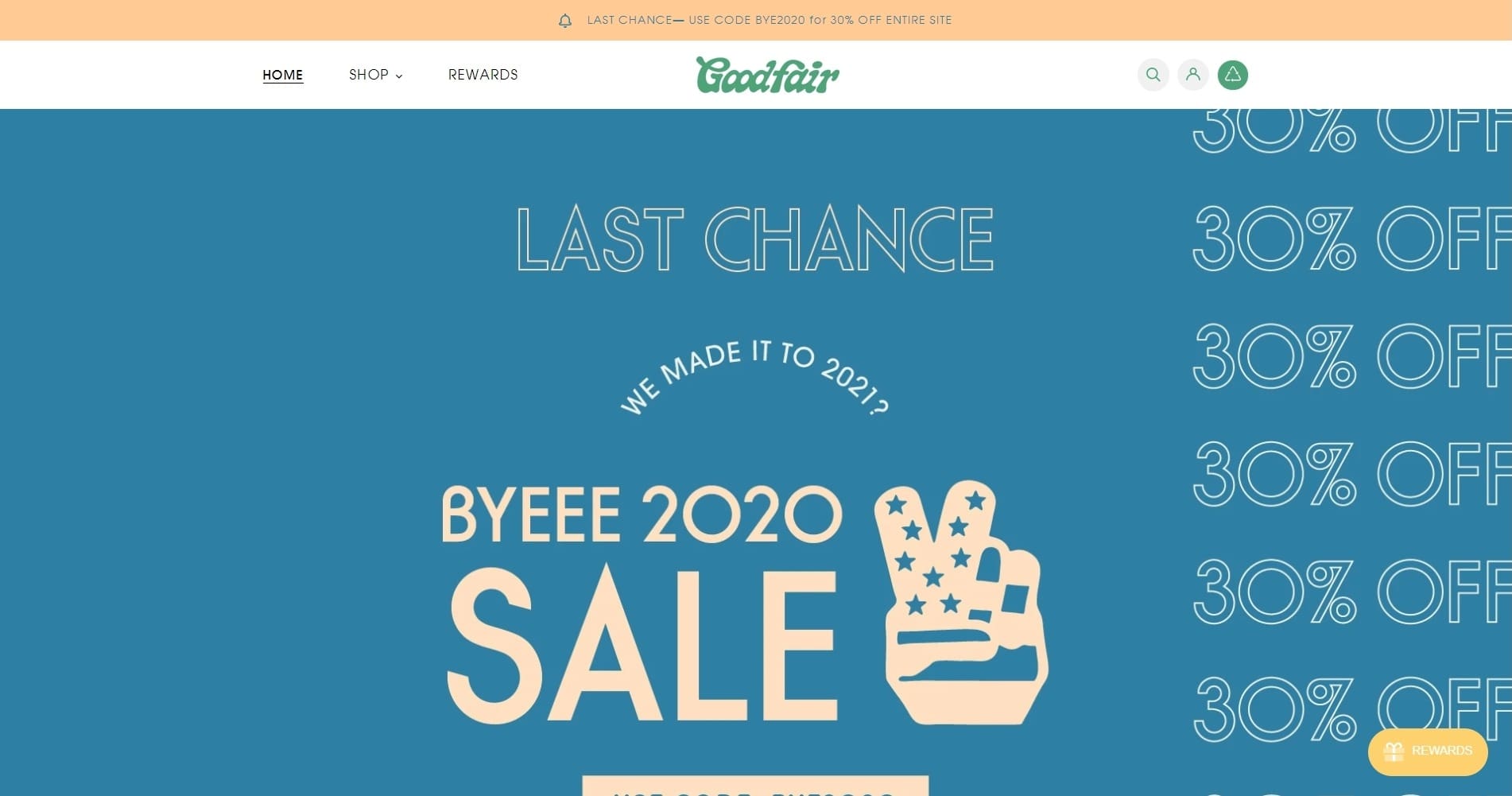
Topper Luciani, the founder of Goodfair, wanted to give clothing headed to landfills a better chance. Unlike other vintage or secondhand clothing retailers, Goodfair doesn’t list their items individually. Instead, customers can buy mystery bundles. This process saves money and time for the company and the amount of savings is passed on to the customers. In the culture of fast fashion, this low-carbon method of Goodfair is changing the way people buy preloved fashion pieces.
For the eCommerce site, Goodfair keeps it simple with a few colors. On the homepage, you can find a video explaining their selling method, some best selling products, and a call to action that lets buyers know they can get free shipping on orders over $99. Also, there is a loyalty program with different tiers, so the more actions customers take the more points they can get.
The best thing to learn about Goodfair is the business model. By introducing a new and exciting way to buy preloved items, the company can build a big loyal customer base - who want to save money and the environment as well.
Kirrin Finch
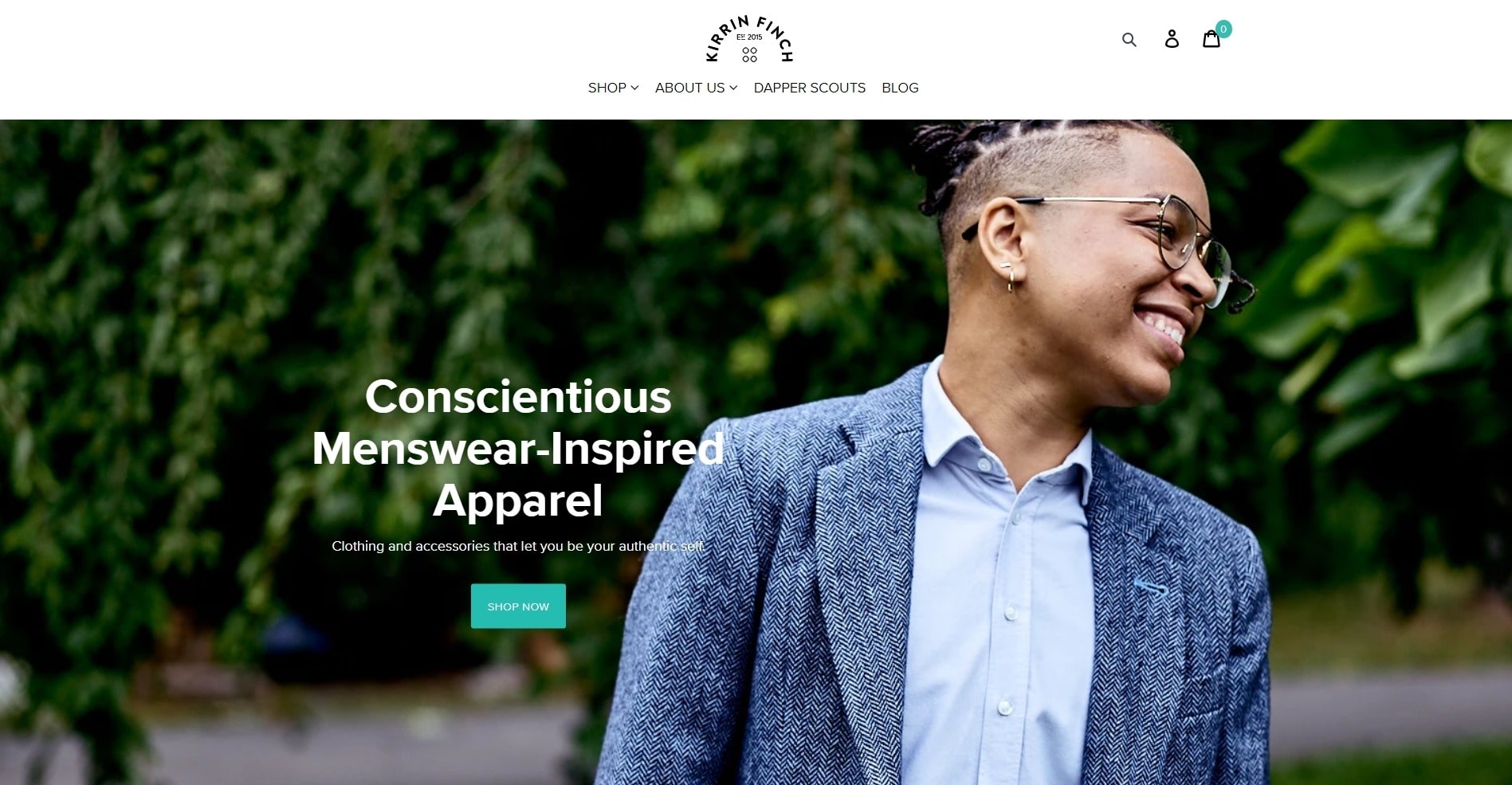
With the equality movement for the LGBT community, clothes are evolving to serve a wider range of requirements as well. Realizing this, Kirrin Finch offers gender-defying items inspired by menswear but are suitable for female and non-binary people. Kelly and Laura Moffat are the founders of the company. Their goal is to create eco-friendly fashion while partnering with ethical manufacturers and fair labor for each garment.
One cool thing that I immediately noticed with Kirrin Finch is that they name their customer group - Dapper Scouts. The group consists of women ambassadors who used Kirrin Finch products and proudly show a new style of fashion for women or non-binary people. By doing this, the brand empowers not only their customers but also future buyers and people in the community.
For the website, you will see the best sellers, the mission statement, size inclusivity, customer reviews, and an Insta shop on the homepage. The product pages are well taken care of with in-detail descriptions and relevant information. The biggest lesson that you can learn from Kirrin Finch is how to build a community and grow your business based on the community’s needs - in this case, gender-defying people.
Adored Vintage
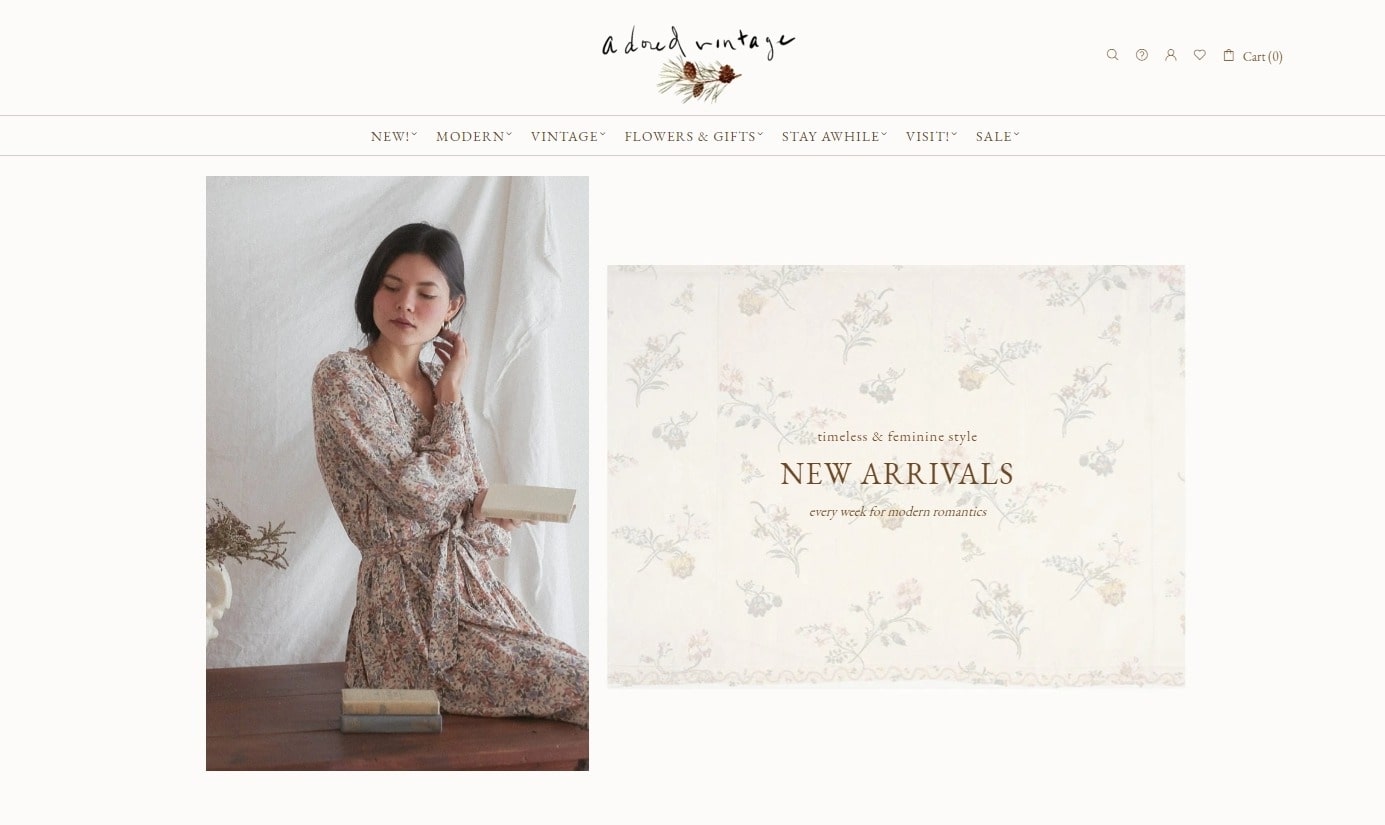
Browsing Adored Vintage’s website, customers will find vintage clothing and vintage-inspired modern pieces. The site is like a virtual escape to a romantic countryside with a dreamy vibe. Everything has elegant colors with sophisticated fonts so buyers can see they are in a different era.
The owner Rodellee Bas curates and creates pieces out of her passion for silhouettes of times past. In the “Vintage” section, you will find items from every decade from the 1910s to the 1990s. Adored Vintage also donates a portion of their revenue to local classrooms, and Rodellee often offers mentor classes to other women in business.
One thing that makes me think the founder is just perfect for this brand is Rodelle’s ability to write. She can write long paragraphs with sincere feelings on the website and social media, making Adored Vintage feel much more personal. The website also uses a social proof popup that lets visitors know when someone just purchased an item. Doing all the right moves, no wonder Adored Vintage is still growing strongly.
Taylor Stitch

Bring back the strong side of man, we have Taylor Stitch as an example for a great Shopify make clothing store. The clothes are constructed to perfection and built for the long haul. With 10 years of experience, the company promises to make the best male items while minimizing the environmental impact.
Not only creating the manliest clothing items, but Taylor Stitch also collaborates with other names like style icons, musicians, and artists to develop new gears for many different activities. There is a section for customers to find all these collaborative collections called “Dispatch”. The brand also has a Workshop section where buyers can crowdfund their new projects and buy at discounted prices.
The website is simple and makes great use of high-quality images. Buyers can not only see how Taylor Stitch’s products look on models but also the details as well. The product page of the eCommerce website has one of the most detailed descriptions I’ve ever seen, and there are certified reviews but no real photos from customers.
How to build a Shopify clothing store
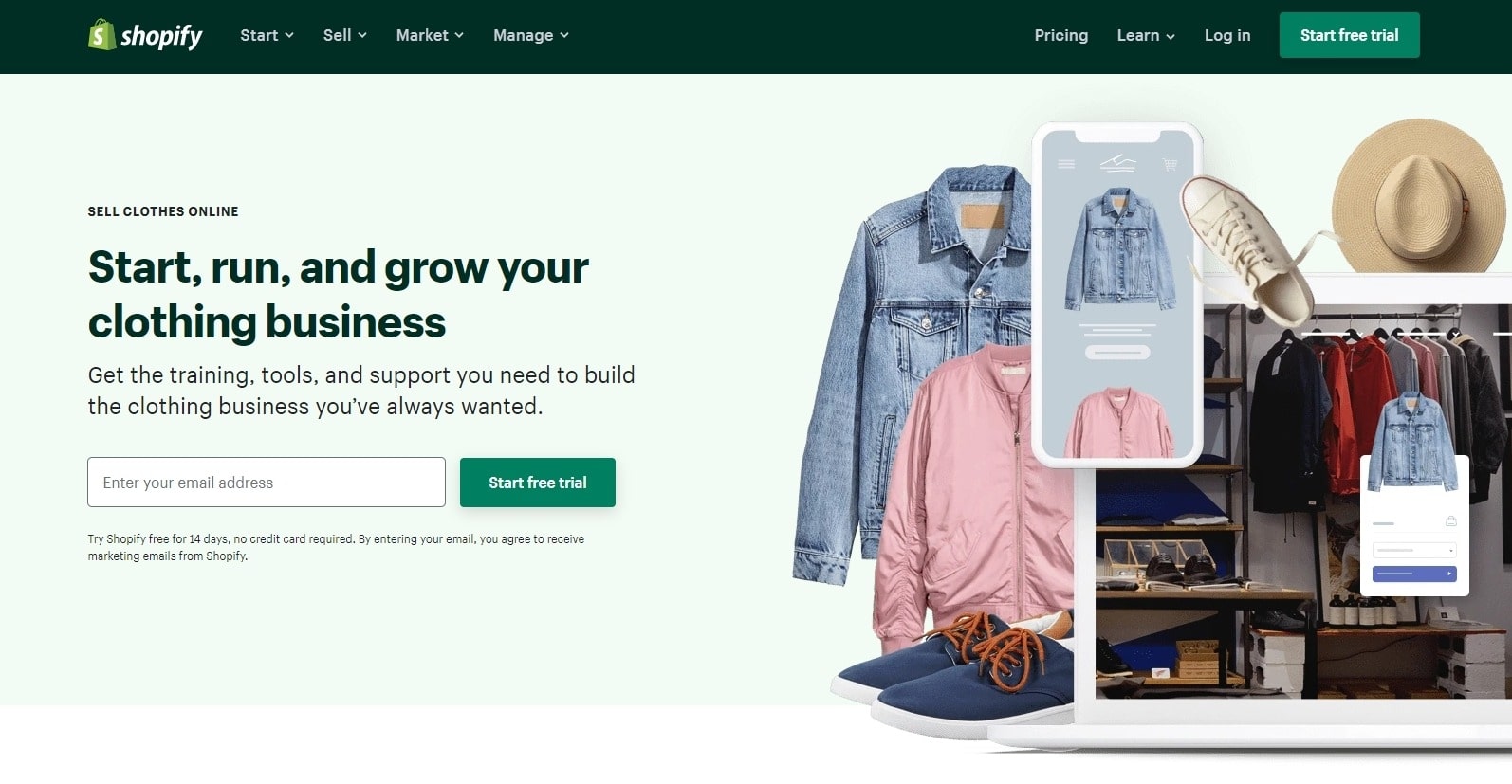
Thanks to a robust eCommerce platform like Shopify, it is now easier than ever to build an online clothing store, and you don’t need to know anything about website development. An online store builder like Shopify lets you drag and drop to create a beautiful and professional storefront, while the backend is taken care of by effective tools for management.
The process to build a Shopify clothing store is simple and intuitive, so anyone can join the Shopify community and start growing more sales. Here are the key steps to start your Shopify clothing store from scratch, and it takes you less than a day to begin.
Step 1: Find your clothing niche
Everyone needs clothes, but people’s needs are not the same. Don’t make your brand’s mission selling clothes to people across every demographic, instead focus on something a little more specific based on your personal preferences and business goals.
When considering niche options for your Shopify clothing store, keep the following points in mind:
- Choose a niche that you love. An idea that excites you and is more likely to succeed in the long run. Think about the types of clothes you buy, what you want to see in the market, and the types of products you would share with friends or family members.
- Be unique to stand out from the crowd. The number of eCommerce clothing stores is hard to count, and if your brand resembles other stores, you can hardly surpass them or even stay in consumers’ minds for a second.
- Make sure the niche has the potential to make money. You may love selling men’s suits, but if countless brands are already selling in this category, your chance to make a name is going to be difficult. Instead, find a place for your brand with a unique value proposition - that allows for faster growth and more earning potential.
- Ask yourself if you can add new values. Your unique background plays a key role in your clothing brand and career goals. For example, if you have experience in nonprofit fields, consider the clothing lines that may be relevant. If this type of strategy doesn’t fit you, see if there are gaps in the current market that you can differentiate or add value to.
Whether you want to focus on high-quality, sustainable items or minority-manufactured sportswear, you need to define the niche for your brand and know the requirements to succeed within it.
Step 2: Use Shopify to build your clothing store
With Shopify, clothing store owners can choose a beautiful theme, add products, and start selling within just a few hours. Not just that, if you use an extension like Oberlo, you can start dropshipping with AliExpress. With many robust tools, Shopify allows you to showcase your clothing products beautifully and build an online store quickly and easily without breaking the bank.
All you need is some products to sell and $29 per month to start. There is also a 14-day free trial for you to play and receive any sales happening during this period. Sound good to go? Then let’s go through the basics of setting a Shopify clothing store.
Step one is easy enough, just head to Shopify.com and insert your email address. If you have a name and a domain already for your store, that is great. Don’t worry, you can change your store’s name later, just be more sure with your store’s domain.
After signing up, you will get access to your Shopify clothing store’s dashboard with all the tools to play with. Here are some key steps that you should take:
- Pick a theme: Shopify has more than 100 design themes to customize your online clothing store. You can tweak the layouts, colors, and images however you like, and check how your site looks on other devices. Some themes are free while most are paid, but a free theme is still a perfect place to start.
- Add products: On the dashboard, click on ‘Add a product’ to start adding your clothing item. Don’t skip on the product descriptions, since they are essential for your customers and website optimization. Then, pick the best images to showcase your clothes, combining with prices, variants, weights, shipping options, etc.
- Add a payment method: The simplest option for many sellers is Paypal, but you can also select Shopify Payment - which lets you accept credit cards directly and reduce transaction costs.
After the essentials above, just hit the ‘publish’ button and your Shopify clothing store is good to go! But, here comes the hardest part - getting customers through the door and turning your store into a successful business.
Step 3: Market your clothing items
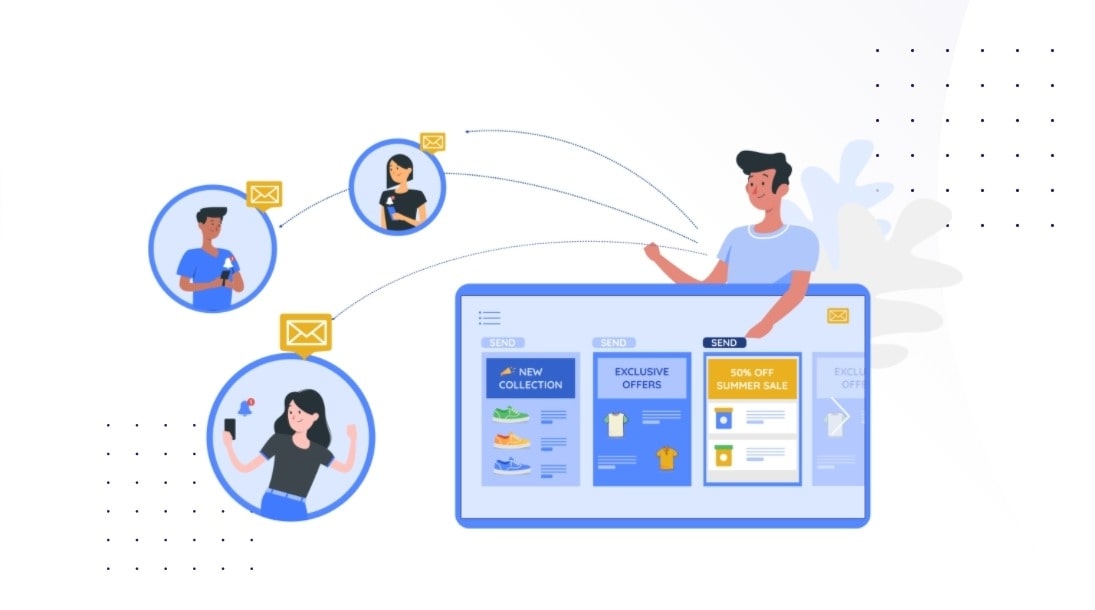
In a competitive eCommerce marketplace, the best way to attract customers is through the effective use of marketing. These tools are the arsenal you need to get your shop off the ground.
I recommend marketing your Shopify clothing store on social media. This is an easy method of getting your brand name more fans at a reasonable price.
You could simply give consumers the chance to like your business account on Facebook or to follow you on Twitter. Through these social platforms, they can keep up with all brand updates, industry news, and any upcoming deals. This also helps you establish a brand’s characteristics, grow your brand, and build up trust with customers.
Integrate social feeds directly into your online store is also a brilliant way to have a higher engagement rate. Your Instagram feed can show real-life examples of people using your products and give buyers more reasons to purchase.
Also, Shopify has an extensive App Store that lets you extend the functionality of your Shopify clothing store. Features such as visitor analytics, social proof, and email address collector are highly beneficial. Online stores in general can make good use of email marketing. You can send personalized updates and promotions to drive more sales with your email campaigns.
Speaking of which, our app Avada Email Marketing is a fantastic option to use email marketing in your Shopify clothing store. You have a selection of beautiful premade email templates and automate timing functions to make the most of your audience.
Another marketing method to keep an eye on is blogging. You can publish pieces to display brand personality, build loyal followings, and grow your community. Blogs are also great to share on social media, promote via emails, and improve SEO. Doing it well will truly establish your clothing brand as a legitimate and trustworthy contender.
Having these marketing tools will help your Shopify clothing store make big bucks in no time at all, so don’t mind trying all at once.
Final advice
You’re now fully aware of what you need in order to set up your Shopify clothing store and start selling. You’re probably also relieved to know it is not as technical as you might’ve thought! With a robust eCommerce platform like Shopify, you can build success with your clothes products without breaking the bank.
Learn from the best Shopify clothing store examples and pave the way for your own brand of clothing. You can do it! If you find the information in this article helpful, make sure to check out our other blog posts on Avada. Thanks for reading!
You Might Also Like:
New Posts






